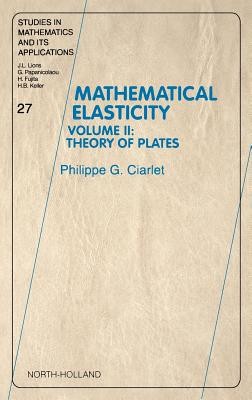
- We will send in 10–14 business days.
- Publisher: North-Holland
- ISBN-10: 0444825703
- ISBN-13: 9780444825704
- Format: 15.6 x 23.4 x 3.2 cm, hardcover
- Language: English
- SAVE -10% with code: EXTRA
Mathematical Elasticity (e-book) (used book) | bookbook.eu
Reviews
Description
The objective of Volume II is to show how asymptotic methods, with the thickness as the small parameter, indeed provide a powerful means of justifying two-dimensional plate theories. More specifically, without any recourse to any a priori assumptions of a geometrical or mechanical nature, it is shown that in the linear case, the three-dimensional displacements, once properly scaled, converge in H1 towards a limit that satisfies the well-known two-dimensional equations of the linear Kirchhoff-Love theory; the convergence of stress is also established.
In the nonlinear case, again after ad hoc scalings have been performed, it is shown that the leading term of a formal asymptotic expansion of the three-dimensional solution satisfies well-known two-dimensional equations, such as those of the nonlinear Kirchhoff-Love theory, or the von Kármán equations. Special attention is also given to the first convergence result obtained in this case, which leads to two-dimensional large deformation, frame-indifferent, nonlinear membrane theories. It is also demonstrated that asymptotic methods can likewise be used for justifying other lower-dimensional equations of elastic shallow shells, and the coupled pluri-dimensional equations of elastic multi-structures, i.e., structures with junctions. In each case, the existence, uniqueness or multiplicity, and regularity of solutions to the limit equations obtained in this fashion are also studied.
EXTRA 10 % discount with code: EXTRA
The promotion ends in 20d.22:31:40
The discount code is valid when purchasing from 10 €. Discounts do not stack.
- Publisher: North-Holland
- ISBN-10: 0444825703
- ISBN-13: 9780444825704
- Format: 15.6 x 23.4 x 3.2 cm, hardcover
- Language: English English
The objective of Volume II is to show how asymptotic methods, with the thickness as the small parameter, indeed provide a powerful means of justifying two-dimensional plate theories. More specifically, without any recourse to any a priori assumptions of a geometrical or mechanical nature, it is shown that in the linear case, the three-dimensional displacements, once properly scaled, converge in H1 towards a limit that satisfies the well-known two-dimensional equations of the linear Kirchhoff-Love theory; the convergence of stress is also established.
In the nonlinear case, again after ad hoc scalings have been performed, it is shown that the leading term of a formal asymptotic expansion of the three-dimensional solution satisfies well-known two-dimensional equations, such as those of the nonlinear Kirchhoff-Love theory, or the von Kármán equations. Special attention is also given to the first convergence result obtained in this case, which leads to two-dimensional large deformation, frame-indifferent, nonlinear membrane theories. It is also demonstrated that asymptotic methods can likewise be used for justifying other lower-dimensional equations of elastic shallow shells, and the coupled pluri-dimensional equations of elastic multi-structures, i.e., structures with junctions. In each case, the existence, uniqueness or multiplicity, and regularity of solutions to the limit equations obtained in this fashion are also studied.


Reviews